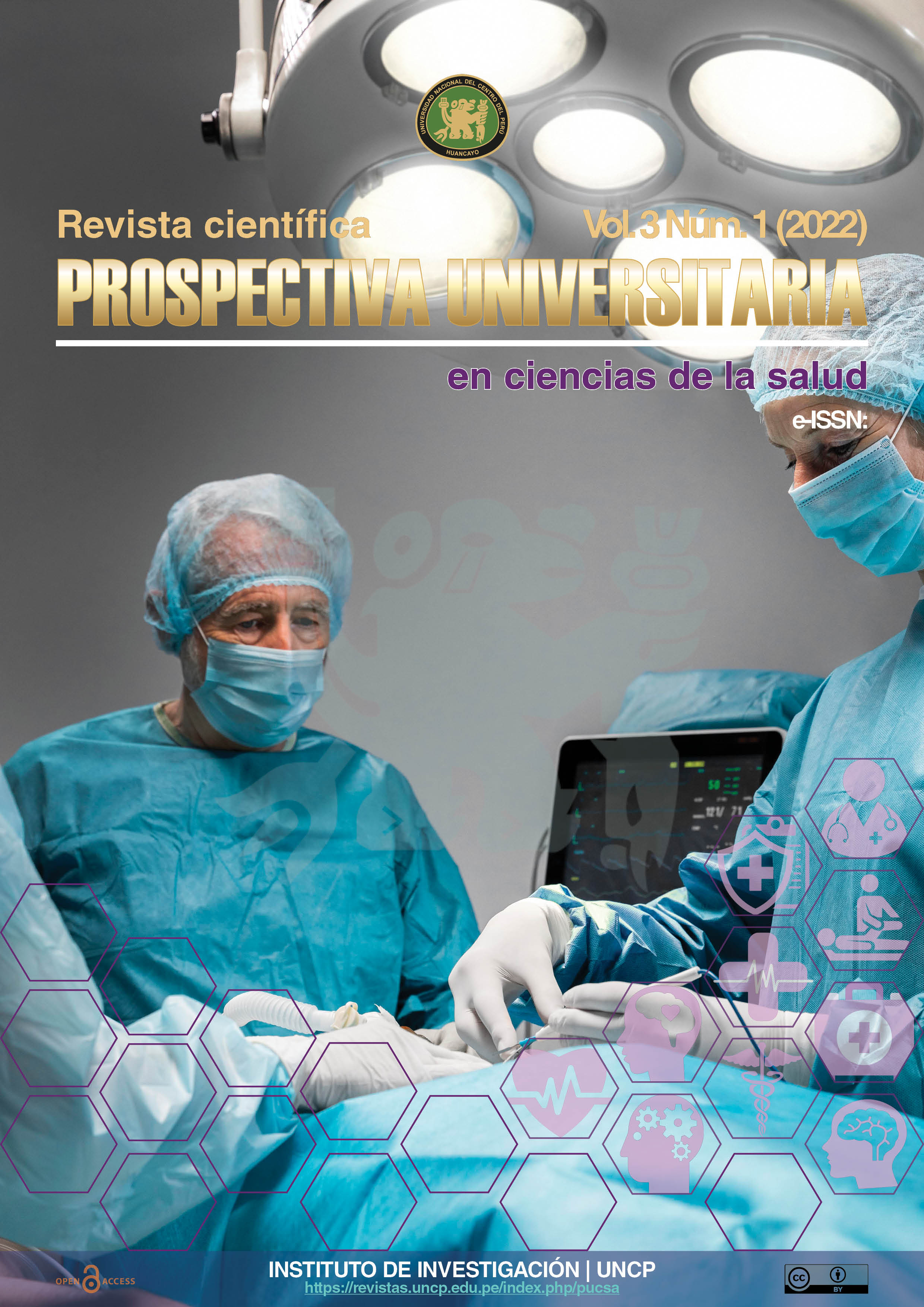Funcionamiento familiar y ludopatía en adolescentes
Palabras clave:
Funcionamiento familiar, Ludopatía, AdolescenciaResumen
Se analizó la relación entre el funcionamiento familiar y el nivel de ludopatía en adolescentes de la institución educativa Mariscal Castilla, El Tambo en el 2019. El estudio fue correlacional de corte transversal, la población estuvo integrada por 105 estudiantes de educación secundaria con edades de 13 y 17 años, se utilizó el cuestionario “FACE III”, para valorar el funcionamiento familiar, también se empleó el “SOUTH OAKS” para evaluar el nivel de ludopatía. Los resultados mostraron que el 49.5% de los adolescentes provienen de familias caóticas, seguido del 23.8% de familias flexibles. En la adaptabilidad, el 39% de los adolescentes pertenecen a familias separadas, seguido de 29.5% que son de familias semi relacionadas. Existe una asociación significativa entre el funcionamiento familiar y la ludopatía, Rho de Spearman (r=-0.4678), p = 0.01. En suma, estos resultados sugieren que el incremento de la funcionalidad familiar disminuye el nivel de ludopatía de adolescentes.
Descargas
Referencias
Bonnaire, C., & Phan, O. (2017). Relationships between parental attitudes, family functioning and Internet gaming disorder in adolescents attending school. Psychiatry Research, 255, 104-110. https://doi.org/10.1016/j.psychres.2017.05.030
Canale, N., Griffiths, M. D., Vieno, A., Siciliano, V., & Molinaro, S. (2016). Impact of Internet gambling on problem gambling among adolescents in Italy: Findings from a large-scale nationally representative survey. Computers in Human Behavior, 57, 99-106. https://doi.org/10.1016/j.chb.2015.12.020
Derevensky, J. L., & Gupta, R. (2007). Internet Gambling Amongst Adolescents: A Growing Concern. International Journal of Mental Health and Addiction, 5(2), 93-101. https://doi.org/10.1007/s11469-007-9057-9
Donati, M. A., Frosini, A., Izzo, V. A., & Primi, C. (2019). The Effectiveness of the Game of Dice Task in Predicting At-Risk and Problem Gambling Among Adolescents: The Contribution of the Neural Networks. Journal of Gambling Studies, 35(1), 1-14. https://doi.org/10.1007/s10899-018-9796-5
González-Roz, A., Fernández-Hermida, J. R., Weidberg, S., Martínez-Loredo, V., & Secades-Villa, R. (2017). Prevalence of Problem Gambling Among Adolescents: A Comparison Across Modes of Access, Gambling Activities, and Levels of Severity. Journal of Gambling Studies, 33(2), 371-382. https://doi.org/10.1007/s10899- 016-9652-4
Gupta, R., & Derevensky, J. L. (2000). Adolescents with Gambling Problems: From Research to Treatment. Journal of Gambling Studies, 16(2/3), 315-342. https://doi.org/10.1023/A:1009493200768
Gupta, R., Nower, L., Derevensky, J. L., Blaszczynski, A., Faregh, N., & Temcheff, C. (2013). Problem Gambling in Adolescents: An Examination of the Pathways Model. Journal of Gambling Studies, 29(3), 575-588. https://doi.org/10.1007/s10899-012-9322-0
Hanss, D., Mentzoni, R. A., Delfabbro, P., Myrseth, H., & Pallesen, S. (2014). Attitudes toward gambling among adolescents. International Gambling Studies, 14(3), 505-519. https://doi.org/10.1080/14459795.2014.969754
King, D. L., & Delfabbro, P. H. (2016). Adolescents’ perceptions of parental influences on commercial and simulated gambling activities. International Gambling Studies, 16(3), 424-441. https://doi.org/10.1080/14459795.2016.1220611
Leeman, R. F., Hoff, R. A., Krishnan-Sarin, S., Patock-Peckham, J. A., & Potenza, M. N. (2014). Impulsivity, Sensation-Seeking, and Part-Time Job Status in Relation to Substance Use and Gambling in Adolescents. Journal of Adolescent Health, 54(4), 460-466. https://doi.org/10.1016/j.jadohealth.2013.09.014
Leong, B. D., Lee, B. Y. H., & Chow, K. K. N. (2018). Collective Play Versus Excessive Use: An Insight into FamilyFocused Design Intervention for Mobile Phone Overuse. International Journal of Mental Health and Addiction, 16(6), 1404-1419. https://doi.org/10.1007/s11469-018-9966-9
Lin, S., Yu, C., Chen, J., Sheng, J., Hu, Y., & Zhong, L. (2020). The Association between Parental Psychological Control, Deviant Peer Affiliation, and Internet Gaming Disorder among Chinese Adolescents: A Two-Year Longitudinal Study. International Journal of Environmental Research and Public Health, 17(21), 8197. https://doi.org/10.3390/ijerph17218197
Lynch, W. J., Maciejewski, P. K., & Potenza, M. N. (2004). Psychiatric Correlates of Gambling in Adolescents and Young AdultsGrouped by Age at Gambling Onset. Archives of General Psychiatry, 61(11), 1116. https://doi. org/10.1001/archpsyc.61.11.1116
Lyu, S. O. (2017). Developmental Process of Internet Gaming Disorder among South Korean Adolescents: Effects of Family Environment and Recreation Experience. Journal of Child and Family Studies, 26(6), 1527-1535. https://doi.org/10.1007/s10826-017-0686-8
Moge, C. E., & Romano, D. M. (2020). Contextualising video game engagement and addiction in mental health: The mediating roles of coping and social support. Heliyon, 6(11), e05340. https://doi.org/10.1016/j.heliyon.2020. e05340
Potenza, M. N., Wareham, J. D., Steinberg, M. A., Rugle, L., Cavallo, D. A., Krishnan-Sarin, S., & Desai, R. A. (2011). Correlates of At-Risk/Problem Internet Gambling in Adolescents. Journal of the American Academy of Child & Adolescent Psychiatry, 50(2), 150-159.e3. https://doi.org/10.1016/j.jaac.2010.11.006
Raisamo, S., Halme, J., Murto, A., & Lintonen, T. (2013). Gambling-Related Harms Among Adolescents: A Population-Based Study. Journal of Gambling Studies, 29(1), 151-159. https://doi.org/10.1007/s10899-012-9298-9
Shaffer, H. J., LaBrie, R., Scanlan, K. M., & Cummings, T. N. (1994). Pathological gambling among adolescents: Massachusetts Gambling Screen (MAGS). Journal of Gambling Studies, 10(4), 339-362. https://doi.org/10.1007/BF02104901
Descargas
Publicado
Número
Sección
Licencia
Derechos de autor 2024 Carmen Yoni Samaniego Durand, Edith Delia Quispe Mateo, Moisés Jesús Calle Cáceres, Ingrid Magaly Calle Samaniego, Patricia Karolan Corilloclla Yaranga

Esta obra está bajo una licencia internacional Creative Commons Atribución 4.0.
![IconJournalPUCSA [ESP] by Edgar Julian-Laime®](https://revistas.uncp.edu.pe/public/journals/29/pageHeaderLogoImage_es.png)







